Learn how to make a perfectly buttery, flaky pie crust from scratch using this in-depth tutorial and video. This page includes all of my best success tips, lots of step-by-step photos, and a thoroughly detailed recipe. Millions of readers have been using this helpful guide since 2015. Become a pro with this crust recipe and the rest will be as easy as… eating salted caramel apple pie!
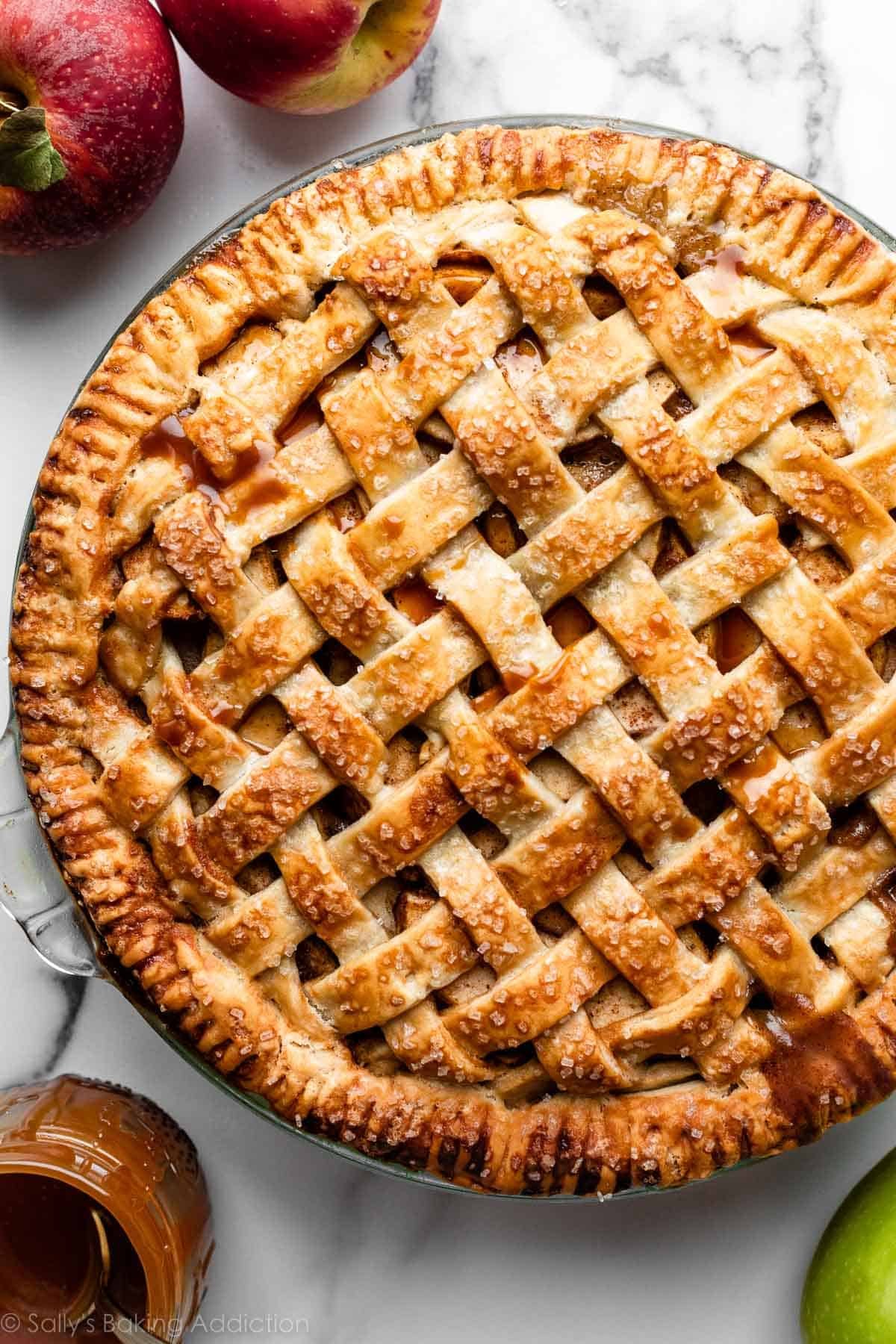
For a baker, there’s nothing more satisfying than making a pie completely from scratch. Pies are often made for special occasions, and there’s a good reason for that: they’re time consuming. This shouldn’t scare you! It should intrigue you. If you’ve ever felt intimidated about making homemade pie crust, I’m here to walk you through it and cheer you on. If I can do this, you can do this.
Pie crust is the foundation for so many delicious desserts (plus savory pies and quiche), so once you build up your confidence in making a crust, you’re opening a door to an entire baking category. And that’s exciting! Whether your favorite pie filling is apple pie or creamy banana cream pie, or even eggs & cheese, the success of the overall pie can really hinge on the quality of the crust.
You wouldn’t hang a beautiful piece of art or favorite photo in a terrible frame, right?
Today I’m teaching you everything about making a buttery, flaky pie crust. This is my absolute favorite pie crust recipe and one of the most popular recipes on this website.
With all the recipe testing that goes into publishing the many pie recipes on this website and in my cookbooks, plus my annual Pie Week, it’s not an understatement to say that I have made a LOT of pies. Along the way, I’ve learned what works and what doesn’t, and I’m happy to share it all with you.
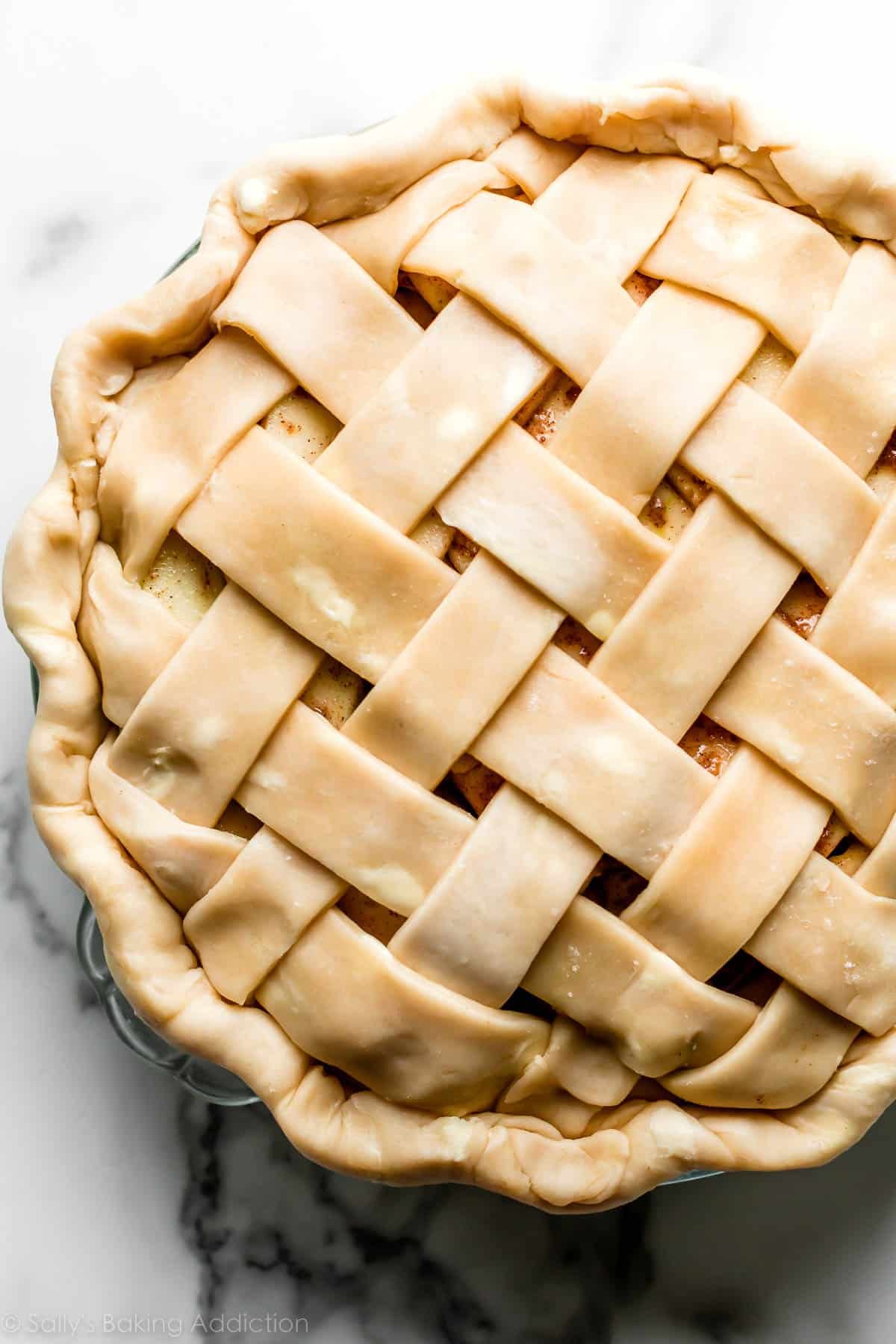
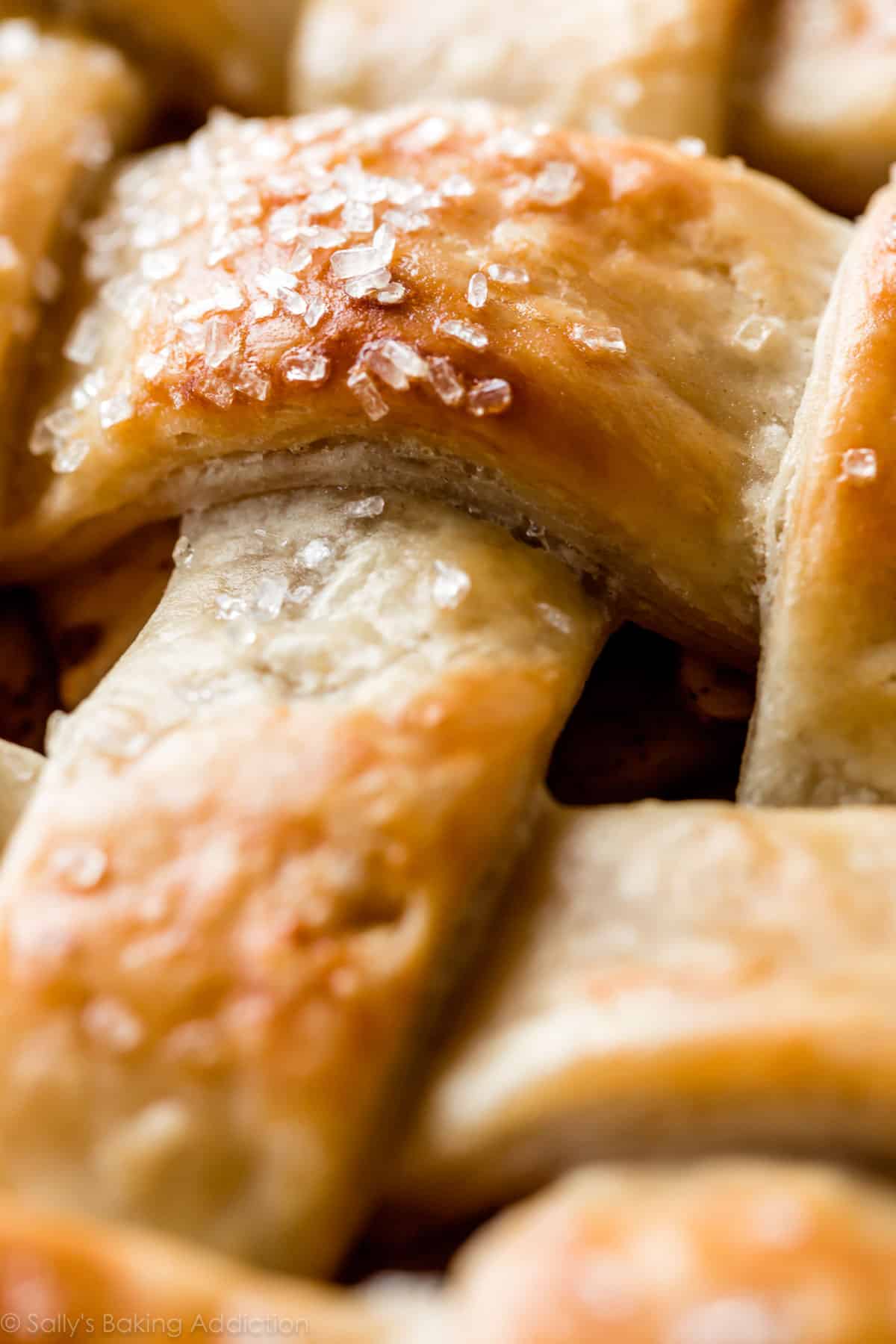
Start With These 5 Ingredients
The ingredient list for pie crust is short & simple:
- Flour: Start with quality flour. Did you know that not all all-purpose flours are equal? King Arthur Unbleached All-Purpose Flour is my go-to for not only pie crust, but for everything. (Not working with the brand, just a true fan!) Why? Its high protein level: “At 11.7% protein, it tops ordinary American all-purpose flours by nearly 2 percentage points.” What does this mean? Baked goods rise higher and stay fresh longer.
- Salt: Enhances the flavor.
- Butter: For that unparalleled buttery flavor and flaky layers.
- Vegetable Shortening: For structure and stability. More on this below.
- Ice water: Liquid brings the dough together. Some recipes call for half water and half vodka, because alcohol doesn’t promote gluten formation, which helps the crust stay flaky and tender. Basically, it’s a gift to anyone who accidentally overworks dough. If you want to try using vodka, use 1/4 cup (60ml) each cold vodka and cold water in this recipe.
You can use this pie dough for so many recipes beyond a traditional pie, too, such as mini pecan pies, mini fruit galettes, apple hand pies, and homemade brown sugar cinnamon pop tarts.
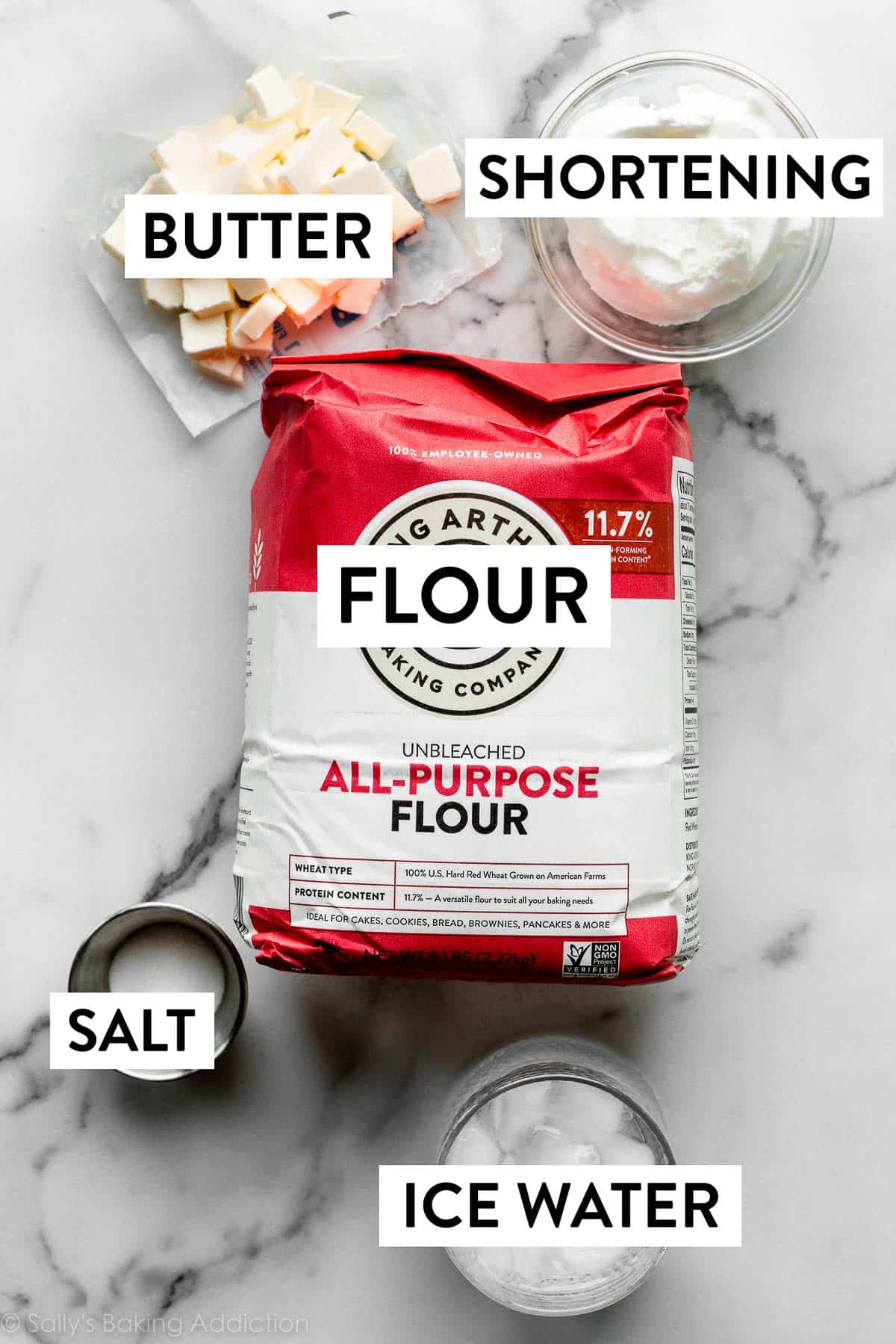
Is Pie Crust Better With Butter or Shortening?
I use BOTH shortening and butter in this pie crust because they work together to make the BEST crust. Buttery, flaky, and tender: the pie-fect trifecta.
- What does butter do? Butter adds flavor and flakiness.
- What does shortening do? Shortening helps the dough stay pliable, which is helpful when you’re rolling and shaping it. Plus, shortening’s high melting point helps the crust stay tender and maintain its shape as it bakes. Have you ever had a butter pie crust lose its shape completely? Shortening is “shape insurance.” 😉
If you don’t want to use shortening, try this all-butter pie crust instead. Let’s compare:
- Using all butter creates a lighter-textured crust and this is due to the butter’s water content. As the crust bakes, the butter’s water converts to steam, lifting up the dough and creating flaky layers. But because of all this butter, the crust doesn’t usually have a perfectly neat-edge/shape compared to the shortening and butter combination.
Both crusts taste buttery and flaky. But overall, this butter-and-shortening crust wins in terms of texture and flavor; AND, if you follow the pie crust recipe carefully, it holds shape too.
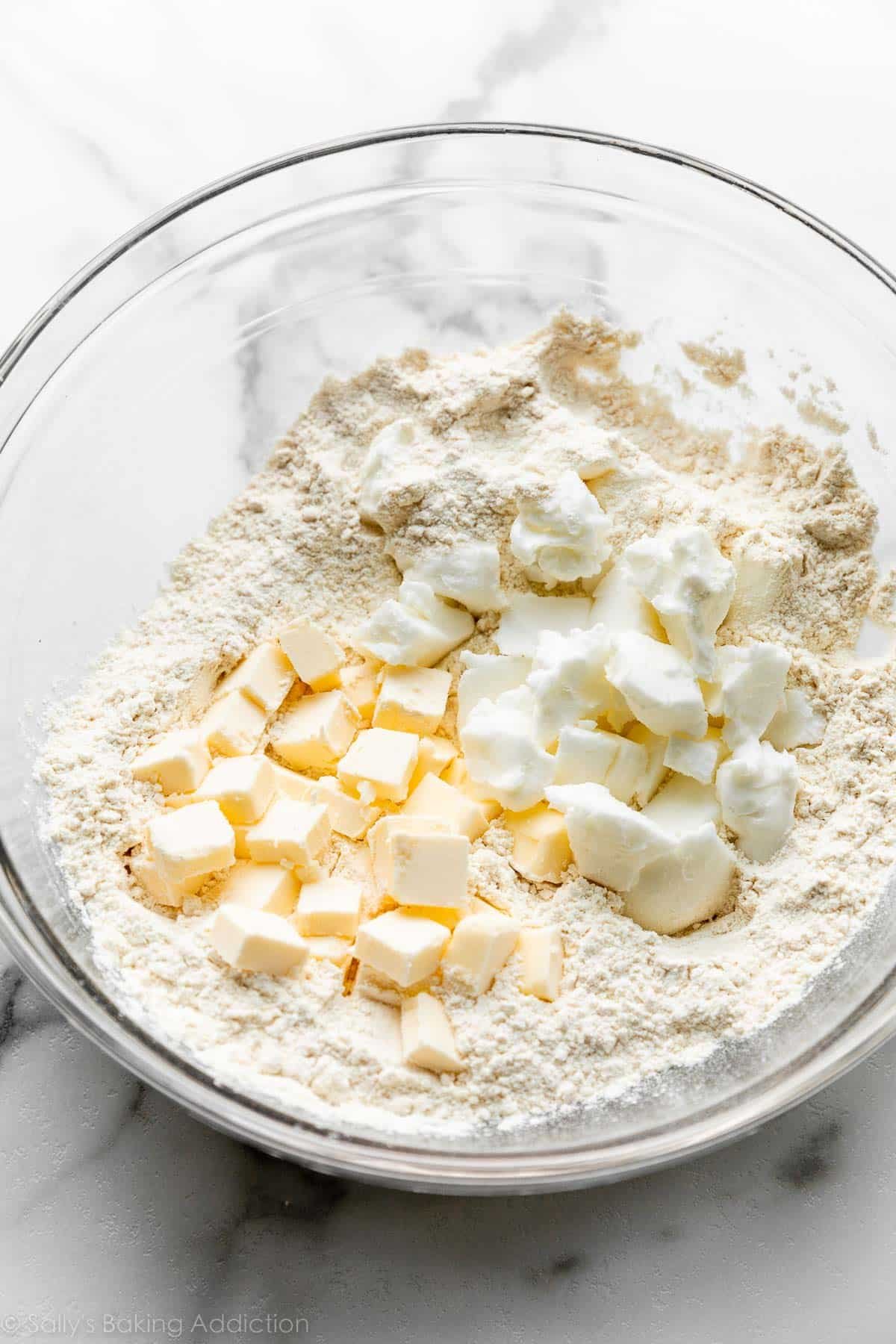
The Secret to Perfect Pie Crust: COLD
The refrigerator is as important as the oven when you’re making a homemade pie.
Why the emphasis on temperature? Keeping your pie dough as cold as possible helps prevent the fats from melting before the crust hits the hot oven. If the butter melts inside the dough before baking, you lose the flakiness. When the lumps of fat melt in the oven as the pie bakes, their steam helps to separate the crust into multiple flaky layers, as explained above. Warm fats will yield a hard, crunchy, greasy crust instead of a tender, flaky crust.
The colder the ingredients, the easier your pie crust is to work with, and the better it will turn out.
Two Tricks to Start as Cold as Possible:
- I keep some of my butter in the freezer and transfer it to the refrigerator a few hours before beginning the crust. This way it is still a little bit frozen and very, very cold. Simply keep the shortening in the refrigerator.
- Mix the dry ingredients together in a large bowl (the flour and salt). Place the bowl in the refrigerator or freezer while you get the rest of the ingredients ready.
These Step-By-Step Photos Will Help
Take the butter and shortening out of the refrigerator. Cube the cold butter and measure out the cold shortening. Give the shortening a little chop—this is actually optional because, truly, the shortening is quite soft even when cold so it’s easy to mix in.
Now it’s time to combine everything. Add the butter and shortening to the dry ingredients, and use a pastry cutter (or 2 forks) to cut in the fats. Some pie crust recipes use a food processor for this, but I don’t recommend it, because it can lead to overworking the fats into the dough, cutting them up too small—which means you’ll need less water and your dough will fall apart. In this step, you’re only breaking up the cold fat into tiny little flour-coated pieces; you’re not completely incorporating it:
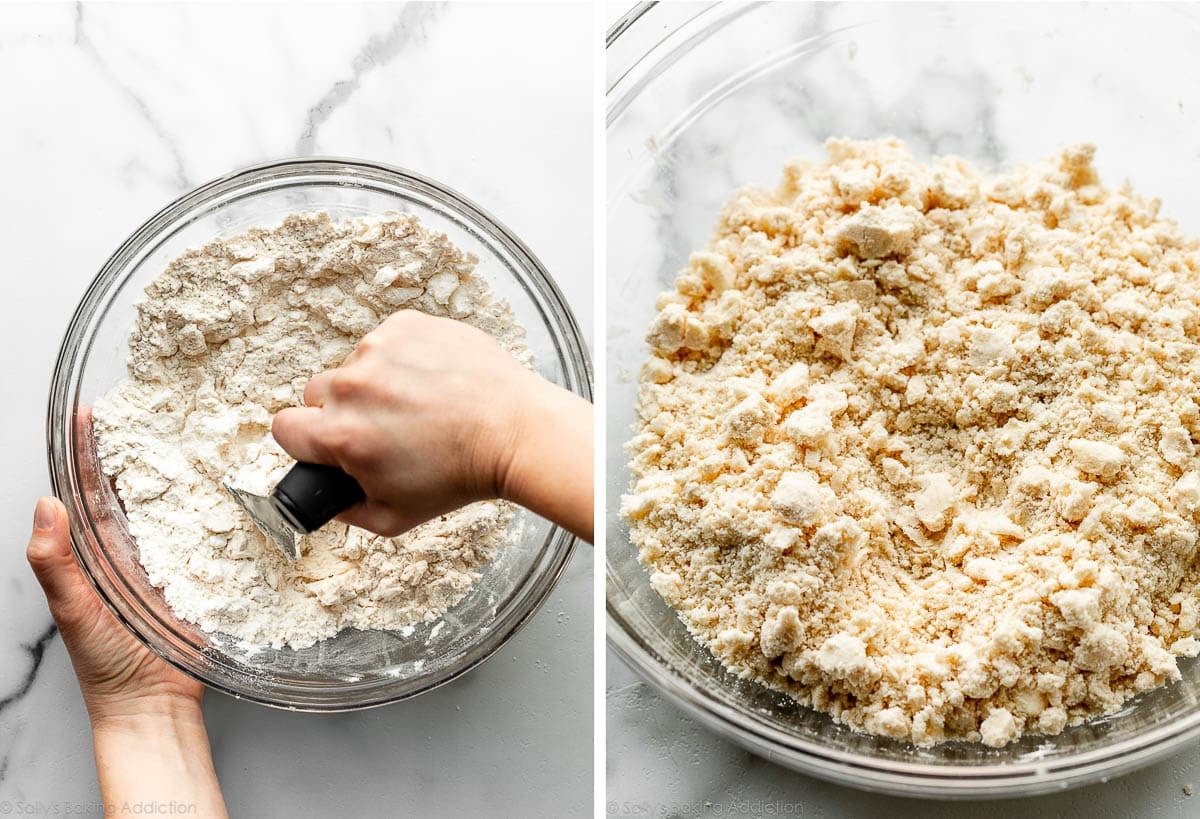
Cut in the fats until the mixture resembles coarse meal—crumbly with lots of lumps, as you see above. You should still have some larger pieces of butter and shortening when you’re done.
From a cup of ice water, measure out 1/2 cup (120ml), since the ice has melted a bit. Drizzle the cold water into the dough 1 Tablespoon (15ml) at a time, stirring after every Tablespoon has been added.
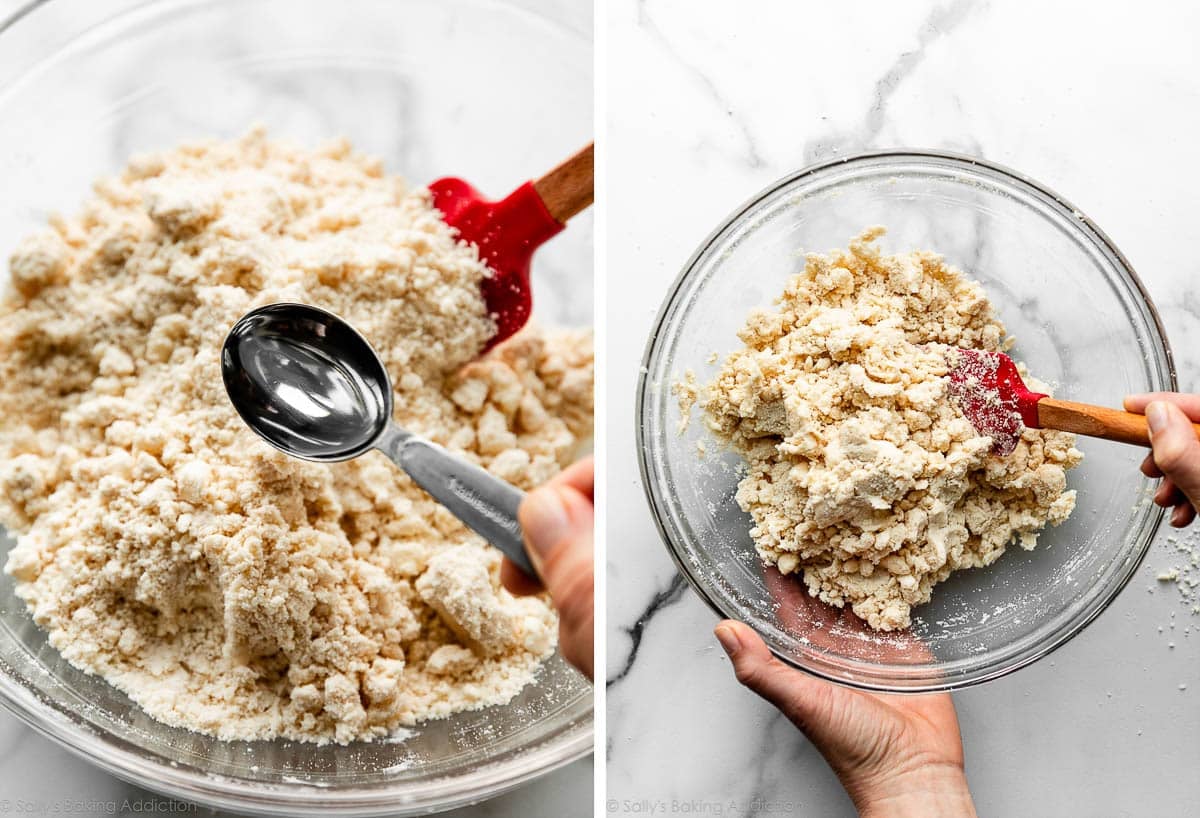
You’ll add just a little water at a time so that you don’t accidentally add too much. Stop adding water when the dough begins to form large clumps. I usually use 1/2 cup (120ml) of water, but if the weather is humid, you may not need as much, and if the weather is really dry, you may need a little more.
If too much water is added, the pie dough will require more flour and become tough.
If too little water is added, you’ll notice the dough is dry and crumbly when you try to roll it out and handle it.
You want the dough to clump together, but not feel overly sticky. Once the dough is clumping together, transfer the dough to a floured work surface.
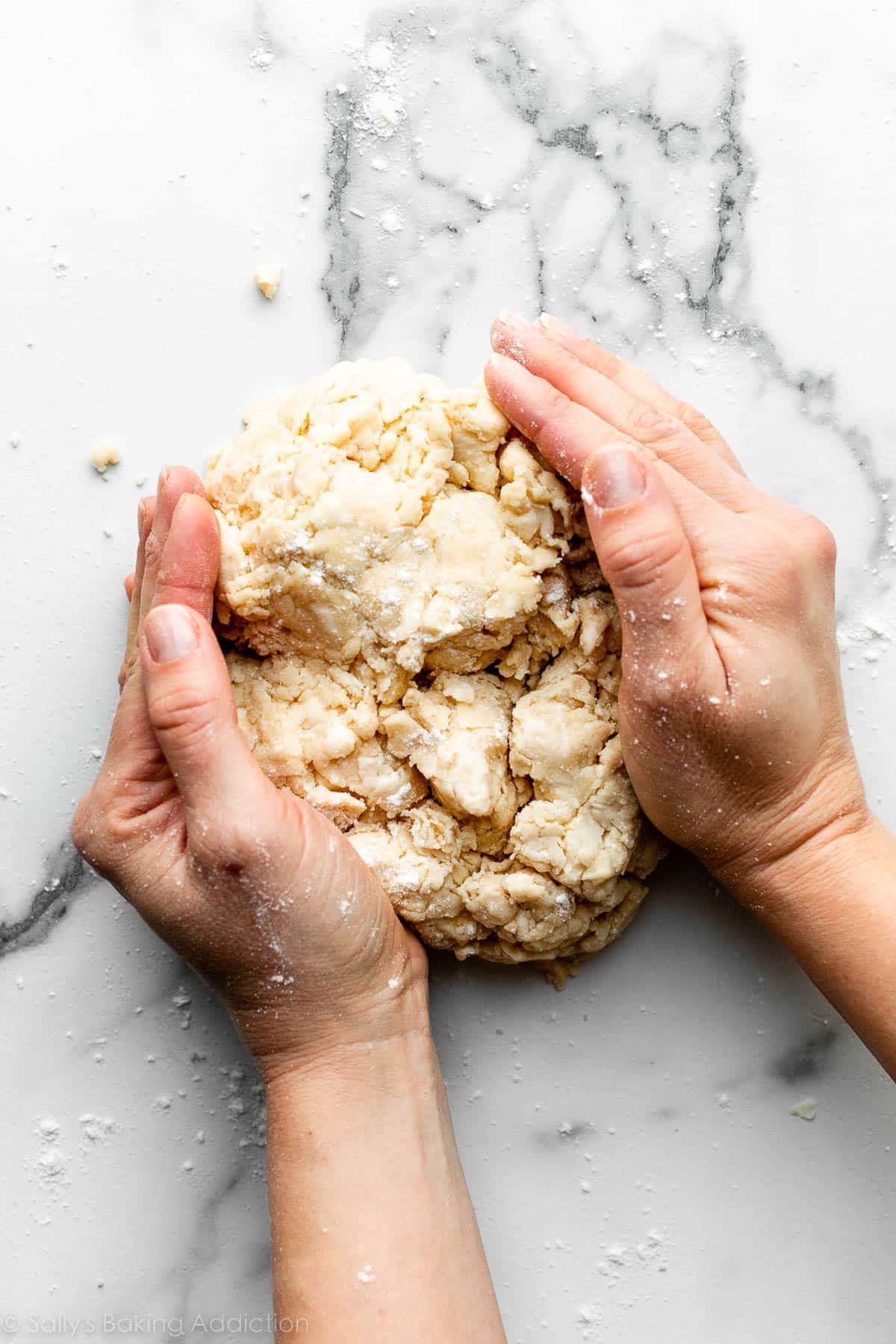
Using floured hands, fold and smush (yes, that’s the technical term) the dough into itself, forming the dough into a ball. Your hands are your best tool, just like when making homemade puff pastry.
The ball of dough should come together easily. If it feels a bit too dry or crumbly, dip your fingers in the ice water and then continue forming the dough with your hands. If it feels too sticky, sprinkle on more flour and then continue forming the dough with your hands.
Once your ball of pie dough has come together, use a sharp knife to cut it in half:
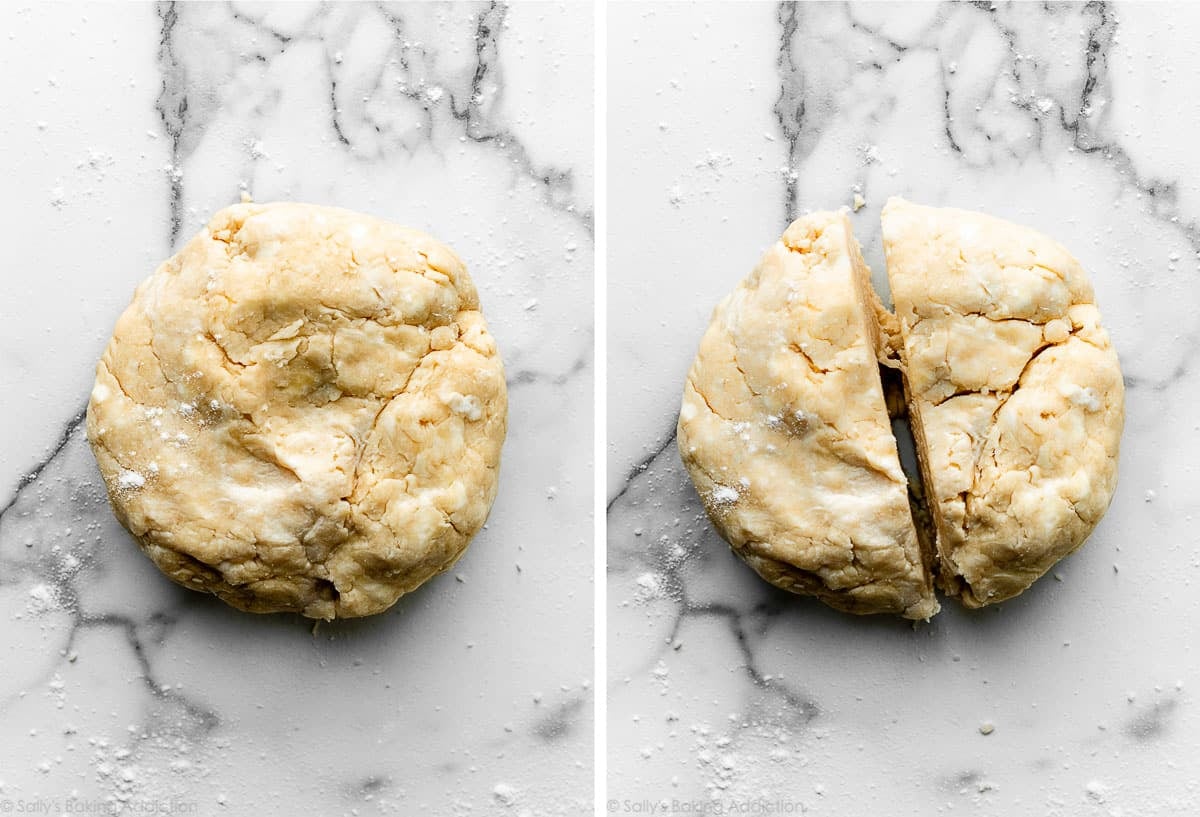
This is enough dough for 2 pie crusts. You can use both crusts for a double-crust pie, like chicken pot pie and strawberry rhubarb pie; or, if your pie doesn’t require a top crust, like coconut cream pie, brownie pie, and lemon meringue pie, save the second pie crust for another pie. You can also roll out the second dough and use cookie cutters to make an easy pie design, like on this pumpkin pie.
Success Tip: Visible Specks and Swirls of Fat in Pie Dough
Take a look at the inside of the dough where you just sliced it. You want to see pieces of butter and flaky layers throughout the pie dough. These specks and swirls of butter and shortening will help ensure a flaky pie dough. They are a GOOD thing!
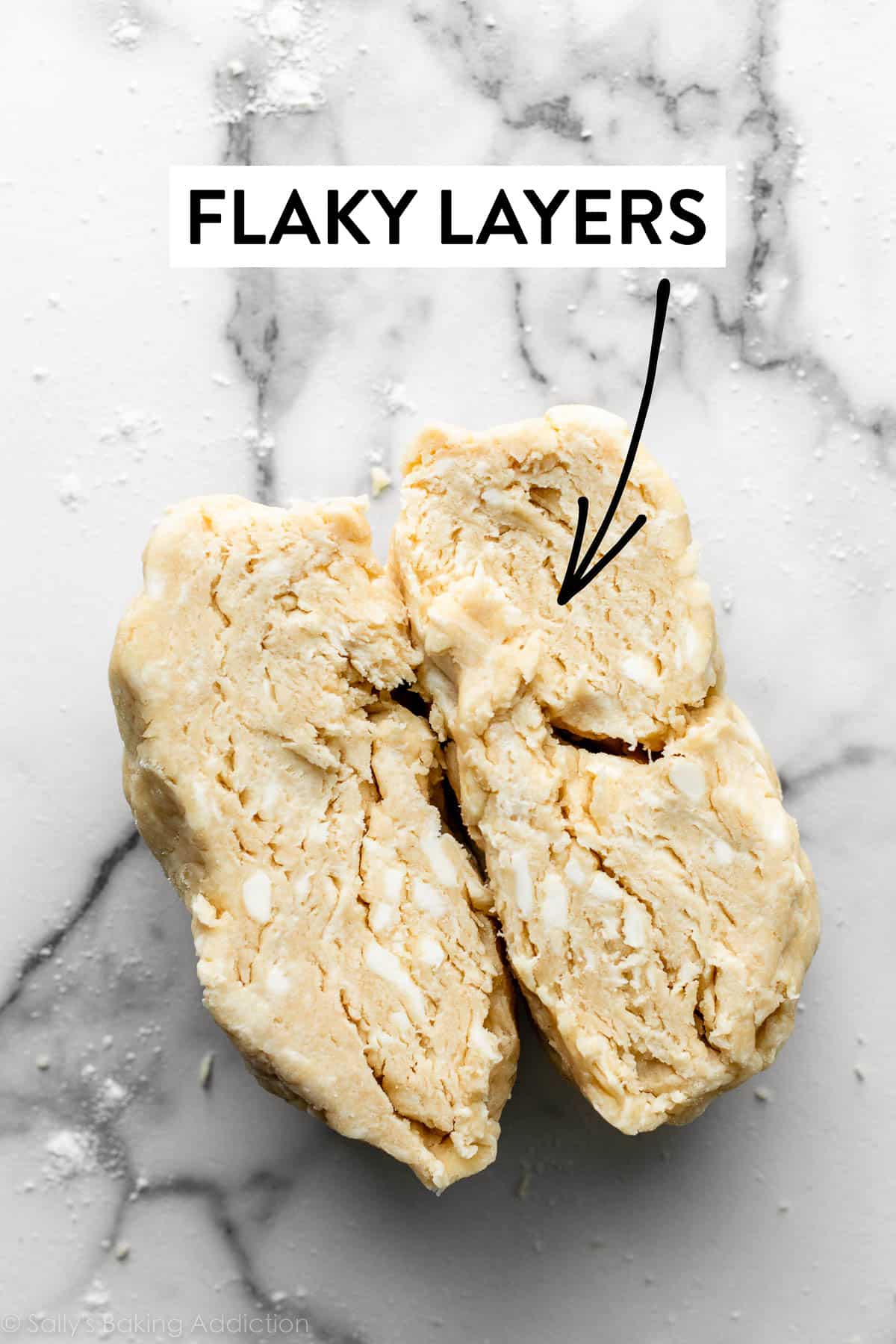
Now your pie dough is ready for a rest in the refrigerator. Flatten each half into 1-inch-thick discs using your hands. The disc shape makes it easier to roll out. Wrap each disc tightly in plastic wrap.
Refrigerate for at least 2 hours or up to 5 days.

Can I Freeze Pie Dough?
Yes, absolutely, and I encourage it! Pie crust freezes beautifully, so it’s a great thing to make ahead of time. Store the tightly wrapped discs of pie dough in the freezer for up to 3 months.
If you know you’re going to want several pies around the holidays, or when your favorite fruit will be in season (cherry pie, anyone?), you can cut down on the amount of time it takes to make pies from scratch the day you want them by making several pie crusts in advance and freezing them.
Thaw the pie crust dough overnight in the refrigerator before rolling it out. It will be extra cold, which is a great starting point.
How to Roll Out Pie Crust
After the dough has chilled for at least 2 hours, you can roll it out. Work with one crust at a time, keeping the other in the refrigerator until you’re ready to roll it out. You’ll need a clean work surface, a rolling pin, and some flour. Lightly flour the work surface, rolling pin, and your hands, and sprinkle a little flour on top of the dough. Use gentle-medium force with your rolling pin on the dough—don’t press down too hard on the dough; you’re not mad at it!
When rolling dough out, start from the center and work your way out in all directions, turning the dough with your hands as you go:
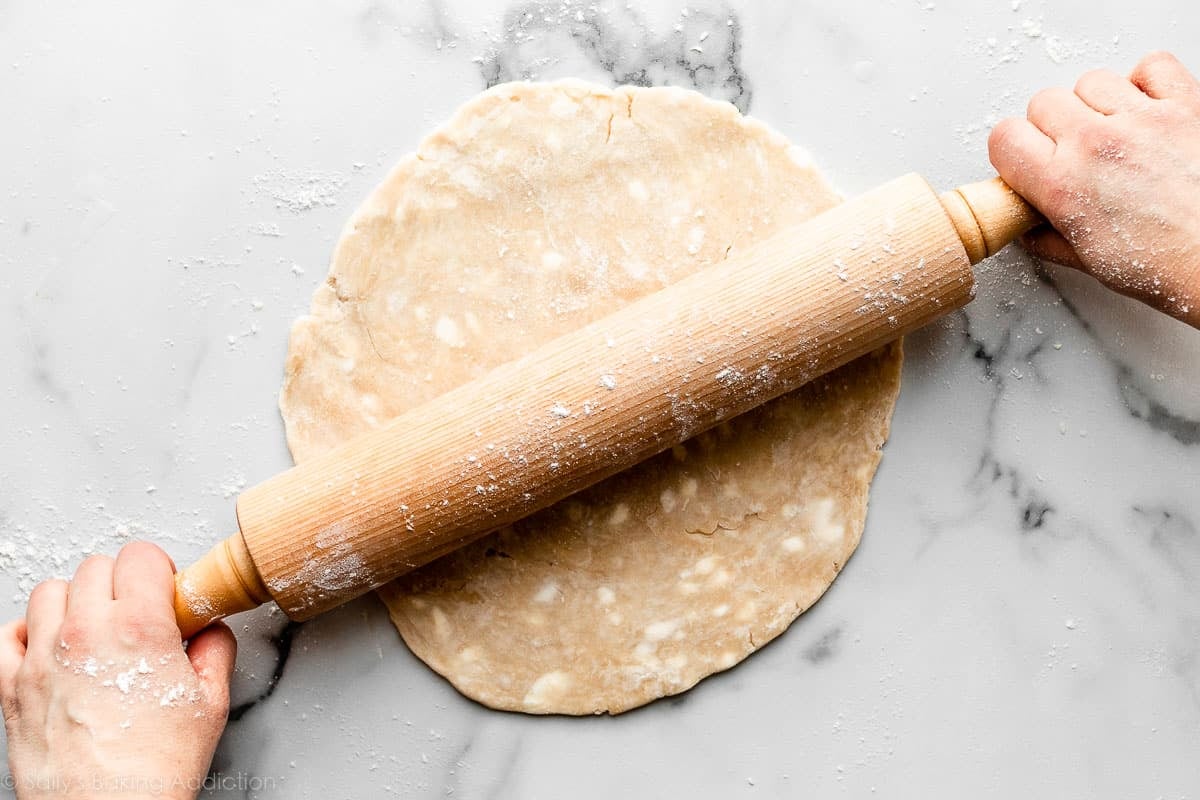
Between passes of the rolling pin, rotate the pie crust and even flip it, to make sure it’s not sticking to your work surface. Sprinkle on a little more flour if it’s sticking. Roll, turn. Roll, turn.
Do you see that beautiful marbling of the butter and shortening throughout the dough? Flaky layers, here you come!
Success Tip: If you notice the dough becoming a lopsided circle as you’re rolling it out, put down the rolling pin and use your hands to help mold the dough back into an even circle:
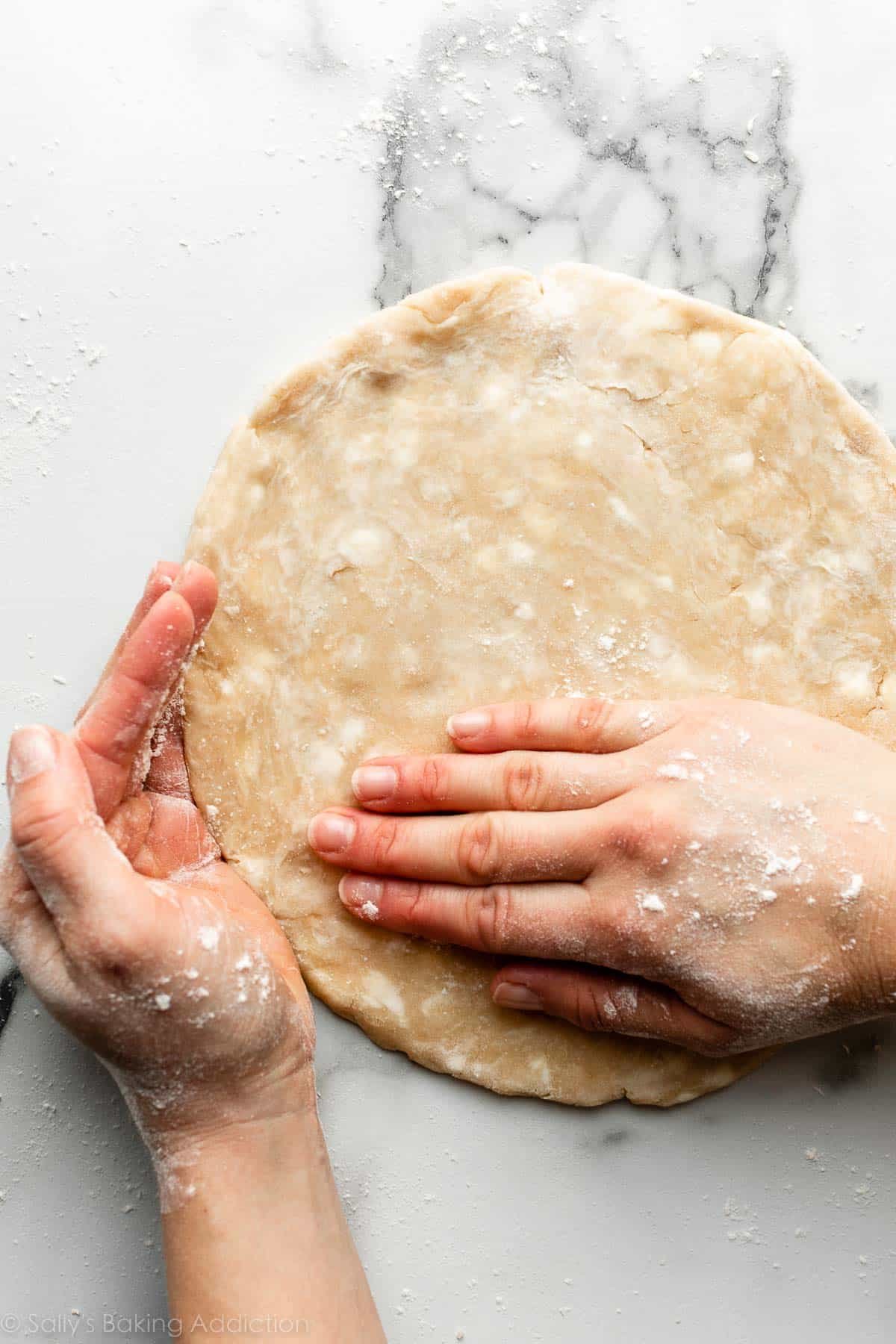
Roll the dough into a thin 12-inch circle, which is the perfect size to fit a 9-inch pie dish. You want enough crust to have some overhang so you can make a decorative edge for your pie.
Your pie dough will be about 1/8-inch thick, which is quite thin.
Success Tip: Since your dough is so thin, use your rolling pin to help transfer the pie crust to the pie dish. Carefully roll one end of the circle of dough gently onto the rolling pin, rolling it back towards you, slowly peeling it off the work surface as you go. Pick it up, and carefully roll it back out over the top of the pie dish. It’s helpful to watch how I do it in the video below.
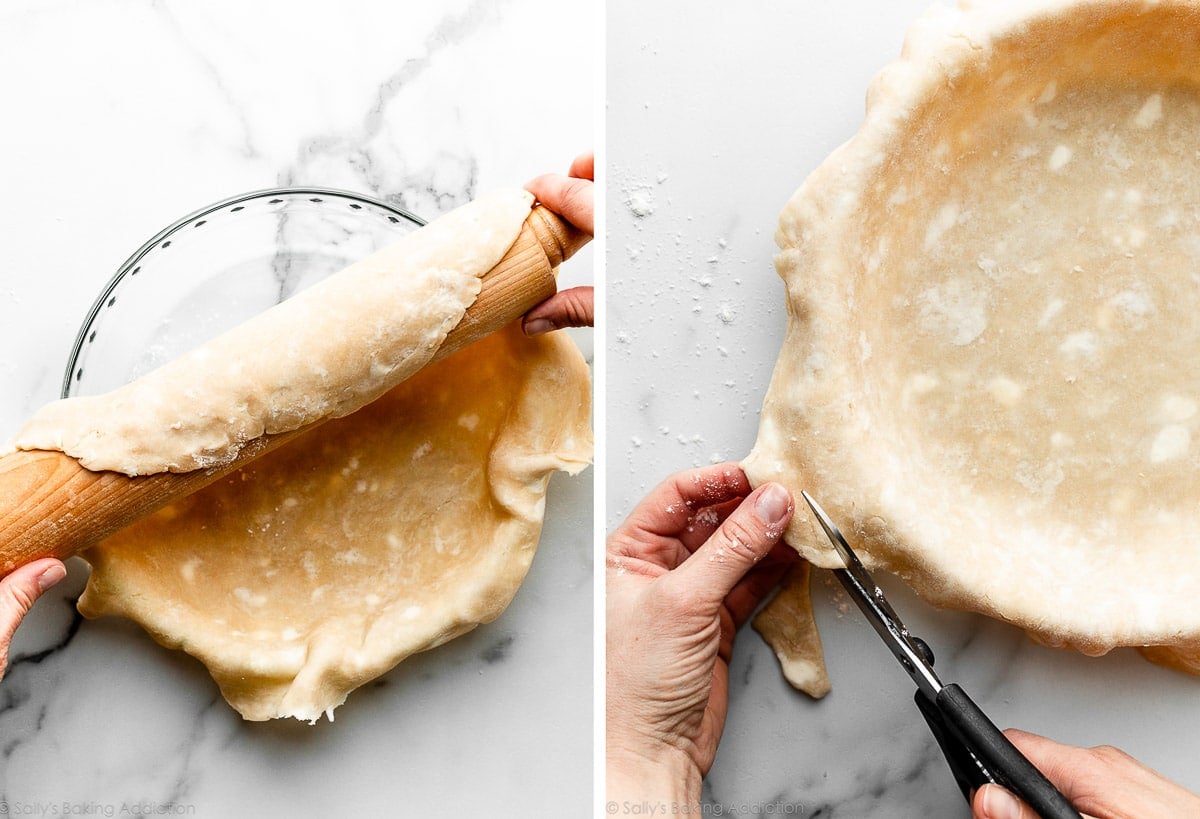
Make sure the pie crust is pretty well centered in the dish, with some overhang all around the sides. Tuck the crust into the pie dish, gently pressing it to the interior all the way around—no air bubbles.
Trim dough around the edges if there’s excess dough in some spots—you want about 1-inch overhang. After you add your pie filling and top crust (such as a lattice pie crust), fold overhang back over and pinch the top and bottom crusts together. Now you can create a pretty edge, such as fluting or crimping. I have a full tutorial on how to crimp and flute pie crust, but here’s a quick overview:
Fluting with fingers: To flute the edges, use a knuckle and 2 fingers to press around the edges of the pie crust, to give it a beautiful and classic scalloped look, like this apple pie.
Crimping with fork: You can also use a fork to crimp the edges, like I do with this peach pie.
Again, review my how to crimp and flute pie crust page and video if you need a little extra help with this step.
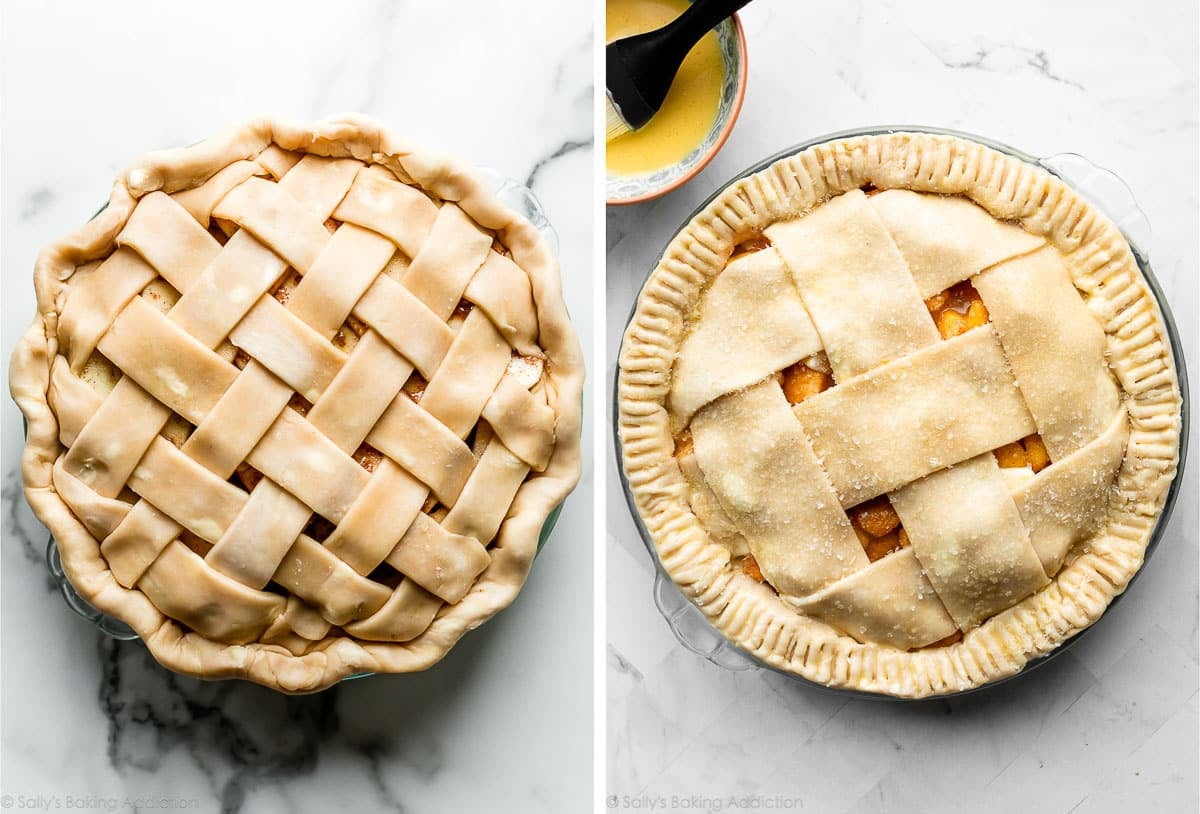
Your pie crust is ready to bake! Follow your pie recipe’s instructions from here; some recipes may call for a fully baked crust, and some may call for a partially baked (par-baked or blind baked) crust. You can read a tutorial on that here in this How to Par-Bake Pie Crust post. And some recipes, like this blueberry pie, don’t require baking the crust at all before adding the filling, because the pie bakes for so long; just spoon/pour the filling right in.
Your pie recipe might call for an egg wash on the dough and for that, use a pastry brush. And if you bake a lot of pies, this list of 10 best pie baking tools will be helpful for you.
Troubleshooting Pie Crust
- Pie crust is tough: Tough crusts are the result of not enough fat in the crust, as well as overworking the dough. Use the recipe below (plenty of fat) and avoid handling the dough more than you need.
- Don’t have enough pie dough: This recipe yields 2 pie crusts. To ensure you have enough pie dough for overhang and a pretty topping, roll your dough out to a 12-inch circle, about 1/8 inch thick.
- Pie crust shrinks down the sides of the dish when baking: This can happen when par-baking a pie crust. See section below.
- Pie dough is dry & cracking around edges when rolling: Use enough ice water when preparing the pie dough. If you work the fats into the dry ingredients too much, the dough will feel too wet before you can add enough water. (And the dough will be dry and thirsty.) Do not overwork the fats in the dry ingredients—you still want those nice crumbles. If it’s too late and you notice the edges of your pie crust are cracking as you roll it out, dip your fingers in ice-cold water and meld the edges back together. Wait a minute, and then try rolling out again.
- Pie dough is falling apart & crumbling when rolling: The dough is likely crumbling because there’s too much fat, and not enough flour and water. Again, this is usually a result of fat being worked in too much, which can easily happen if the ingredients weren’t cold enough. (Refrigerate those dry ingredients before you start!) If it’s too late and the pie dough is crumbling as you roll it out, try adding more water AND more flour. Sprinkle a tiny bit of ice water and flour onto the cracks and crumbled pieces, and gently work it all in with your fingers. Wait a minute, and then try rolling out again.
Gently work ice water drops and flour into your crumbly pie dough to bring it back together:
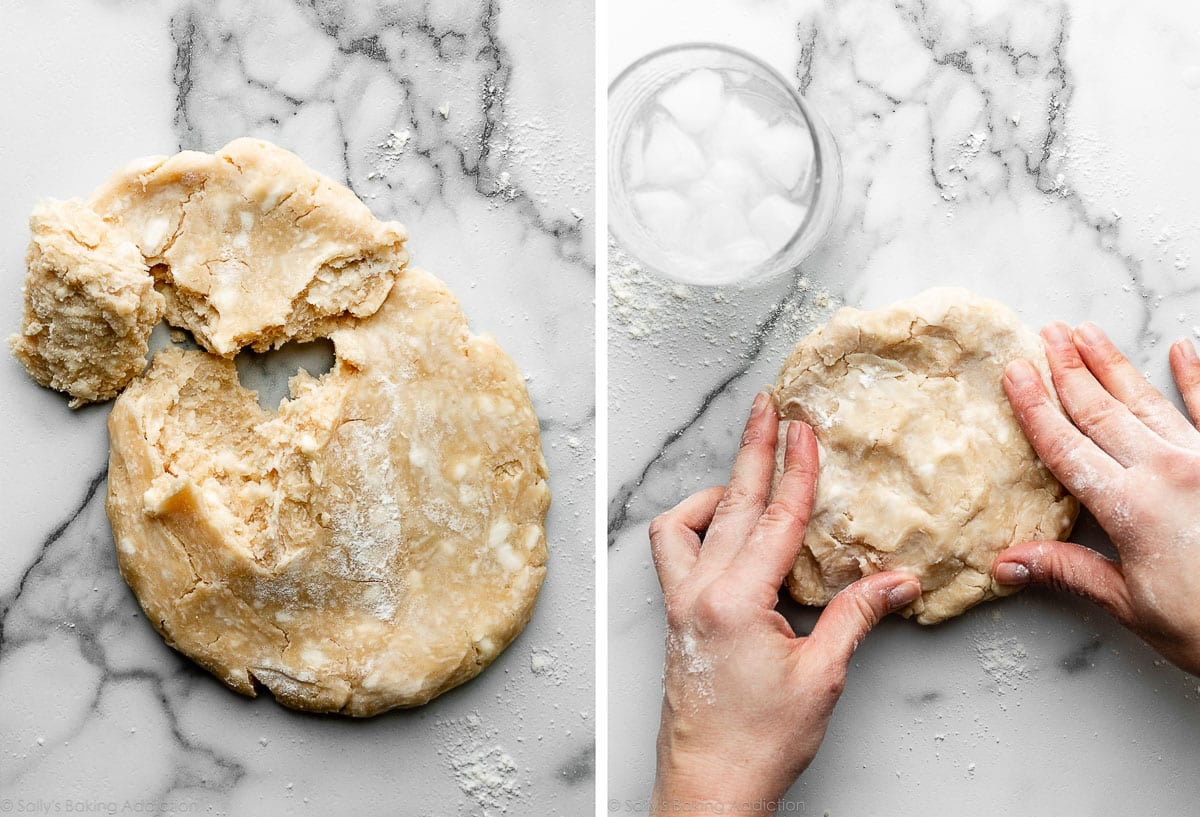
Blind Baking Pie Crust
If your pie recipe requires a fully baked or par-baked pie crust before adding the filling, follow the directions and success tips in this How to Par-Bake Pie Crust guide. You need 2 packs of pie weights, which are metal or ceramic beads that serve to weigh down the crust to prevent the puffing/shrinking. You could use dried beans instead. Whichever you choose, be sure to line the crust with parchment paper, then fill the empty pie crust shell with the weights prior to baking. Without pie weights, the dough will puff up, and then shrink down the sides.
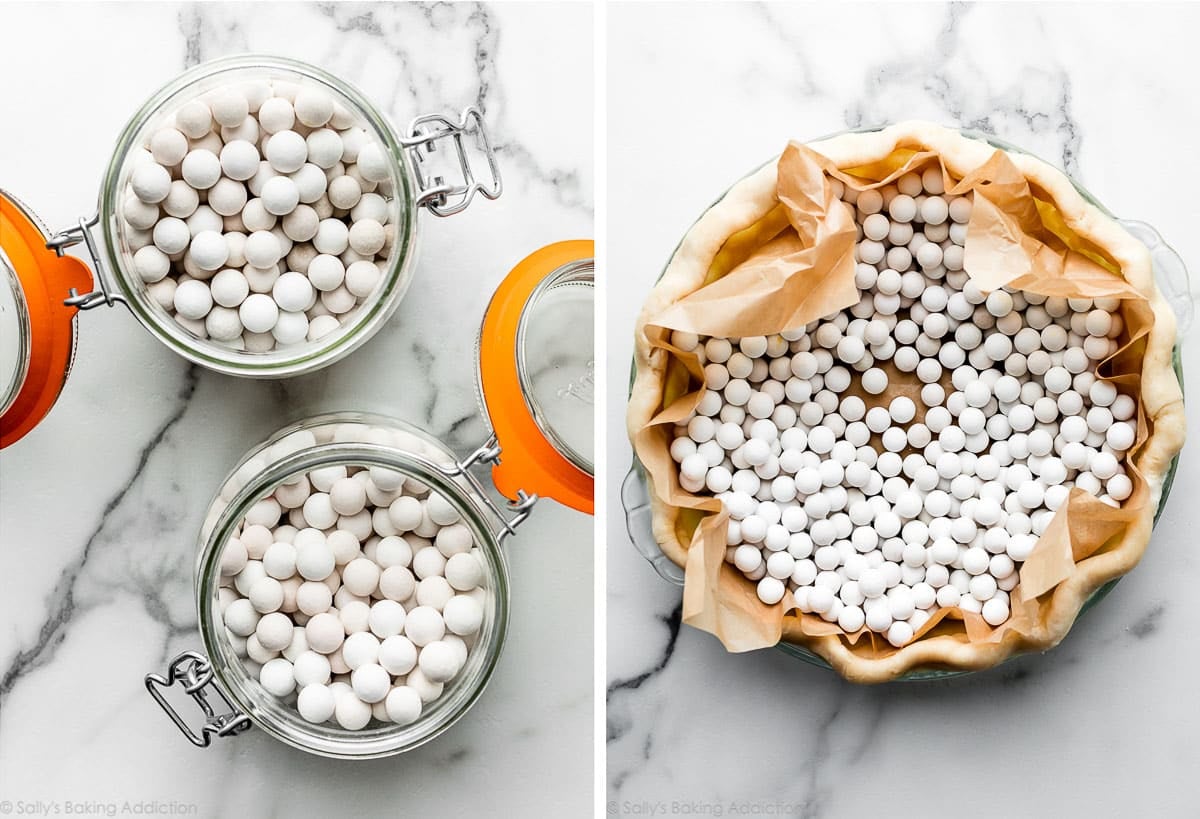
Pie Crust Success Tips
- Use a glass pie dish. I prefer using a glass pie dish when I make pie. Why? Glass dishes conduct heat evenly, which allows the bottom of the crust to bake thoroughly. Also, you’ll be able to see when the sides and bottom of the crust have browned.
- The refrigerator is pie dough’s best friend. Keep everything cold every step of the way: ingredients, the bowl, and the dough before rolling. When taking the pie crust out of the refrigerator to roll out and fill, make sure your pie filling is ready to go. If not, keep the pie crust in the refrigerator until it is.
- Keep dough cold when rolling out: Warm pie dough is unworkable. If the dough becomes too warm when you’re rolling it out, stop what you’re doing, pick it up as gently as you can, put it on a plate or small baking sheet, and then cover and refrigerate it for 10–20 minutes.
- Protect the crust edges from burning: Use a pie crust shield to prevent the edges from burning. A shield keeps the crust edge covered, but the center of the pie exposed, protecting the edges. I usually just make a pie shield out of a piece of aluminum foil. Take a piece of aluminum foil and fold it in half. Cut out a half circle. When you open it back up, you’ll have a square of foil with a circle cut out of the center. If you notice the edges of your pie crust are browning before the pie has fully baked, carefully and gently place the foil over the top of the pie, centering the cut-out hole over the pie. Carefully (obviously it’s very hot!) and lightly tuck the sides of the foil around the pie crust edges, then let the pie finish baking.
- Create a beautiful topping: For designing the top crust, see How to Lattice Pie Crust, How to Braid Pie Crust, or these Pie Crust Designs. And here is my tutorial on How to Crimp and Flute Pie Crust, too.
For more pie crust inspiration, see my graham cracker crust and homemade chocolate pop tarts (with a chocolate crust!).
Print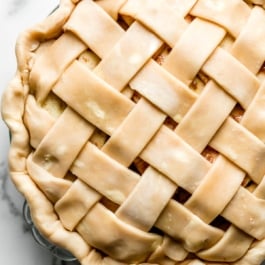
Homemade Buttery Flaky Pie Crust Recipe
- Prep Time: 15 minutes
- Cook Time: 0 minutes
- Total Time: 2 hours, 15 minutes
- Yield: 2 pie crusts (1 lb, 8 ounces dough total)
- Category: Pie
- Method: Baking
- Cuisine: American
Description
This recipe is enough for a double crust pie. If you only need 1 crust for your pie, freeze the other half per the Freezing Instructions below. Is your pie dough tearing, cracking, or crumbling as you try to roll it out? See recipe Notes.
Ingredients
- 2 and 1/2 cups (315g) all-purpose flour (spooned & leveled), plus more for shaping and rolling
- 1 teaspoon salt
- 6 Tablespoons (85g) unsalted butter, chilled and cubed
- 2/3 cup (130g) vegetable shortening, chilled
- 1/2 cup (120ml) ice cold water
Instructions
- Whisk the flour and salt together in a large bowl.
- Add the butter and shortening. Using a pastry cutter or two forks, cut the butter and shortening into the mixture until it resembles coarse meal (pea-sized bits with a few larger bits of fat is OK). In this step, you’re only breaking up the cold fat into tiny little flour-coated pieces; you’re not completely incorporating it. Do not overwork the ingredients.
- Measure 1/2 cup (120ml) of water in a cup. Add ice. Stir it around. From that, measure 1/2 cup (120ml) of water, since the ice has melted a bit. Drizzle the cold water in, 1 Tablespoon (15ml) at a time, and stir with a rubber spatula or wooden spoon after every Tablespoon has been added. Stop adding water when the dough begins to form large clumps. I always use about 1/2 cup of water, and need a little more in dry winter months. Do not add any more water than you need.
- Transfer the pie dough to a floured work surface. Using floured hands, fold the dough into itself until the flour is fully incorporated into the fats. The dough should come together easily and should not feel overly sticky. Avoid overworking the dough. If it feels a bit too dry or crumbly, dip your fingers in the ice water and then continue bringing dough together with your hands. If it feels too sticky, sprinkle on more flour and then continue bringing dough together with your hands. Form it into a ball. Use a sharp knife to cut it in half. If it’s helpful, you should have about 1 lb, 8 ounces dough total (about 680g). Gently flatten each half into 1-inch-thick discs using your hands.
- Wrap each tightly in plastic wrap. Refrigerate for at least 2 hours and up to 5 days.
- After the dough has chilled for at least 2 hours, you can roll it out. Work with one crust at a time, keeping the other in the refrigerator until you’re ready to roll it out. Lightly flour the work surface, rolling pin, and your hands, and sprinkle a little flour on top of the dough. Use gentle-medium force with your rolling pin on the dough—don’t press down too hard on the dough; you’re not mad at it! When rolling dough out, start from the center and work your way out in all directions, turning the dough with your hands as you go. Between passes of the rolling pin, rotate the pie crust and even flip it, to make sure it’s not sticking to your work surface. Sprinkle on a little more flour if it’s sticking; don’t be afraid to use a little more flour. If you notice the dough becoming a lopsided circle as you’re rolling it out, put down the rolling pin and use your hands to help mold the dough back into an even circle. Roll the dough into a very thin 12-inch circle, which is the perfect size to fit a 9-inch pie dish. Your pie dough will be about 1/8 inch thick, which is quite thin. Visible specks of butter and fat in the dough are perfectly normal and expected.
- Because your dough is so thin, use your rolling pin to help transfer the pie crust to the pie dish. Carefully roll one end of the circle of dough gently onto the rolling pin, rolling it back towards you, slowly peeling it off the work surface as you go. Pick it up, and carefully roll it back out over the top of the pie dish. It’s helpful to watch how I do it in the video below.
- Proceed with the pie per your recipe’s instructions. If your dough requires par-baking, see helpful How to Par-Bake Pie Crust tutorial.
Notes
- Make Ahead & Freezing Instructions: Prepare the pie dough through step 5 and freeze the discs for up to 3 months. Thaw overnight in the refrigerator before using in your pie recipe.
- Special Tools (affiliate links): Large Glass Mixing Bowl | Pastry Cutter | Rolling Pin | For more tools you may need to completely assemble and bake your pie, see my 10 Best Pie Baking Tools list.
- Salt: Use regular table salt. If using kosher salt, use 1 and 1/4 teaspoons.
- Shortening: This recipe uses a butter and shortening combination. Butter for flakiness and flavor, and shortening for its high melting point and ability to help the crust hold shape. You can use butter-flavor shortening if desired. If you want to skip the shortening, feel free to try this all-butter pie crust instead. Some readers have substituted lard for shortening in this recipe with success.
- Can I use a food processor? You can use a food processor to bring the dough ingredients together in step 1, but I find it quickly overworks the dough. For best results and a light, flaky crust, I recommend a pastry cutter.
- Pie dough is dry & cracking around edges when rolling: Use enough ice water when preparing the pie dough. If you work the fats into the dry ingredients too much, the dough will feel too wet before you can add enough water. (And the dough will be dry and thirsty.) Do not overwork the fats in the dry ingredients—you still want those nice crumbles. If it’s too late and you notice the edges of your pie crust are cracking as you roll it out, dip your fingers in ice-cold water and meld the edges back together. Wait a minute, and then try rolling out again.
- Pie dough is falling apart & crumbling when rolling: The dough is likely crumbling because there’s too much fat, and not enough flour and water. Again, this is usually a result of fat being worked in too much, which can easily happen if the ingredients weren’t cold enough. (Refrigerate those dry ingredients before you start!) If it’s too late and the pie dough is crumbling as you roll it out, try adding more water AND more flour. Sprinkle a tiny bit of ice water and flour onto the cracks and crumbled pieces, and gently work it all in with your fingers. Wait a minute, and then try rolling out again.
- More Crusts: If you need more than 2 pie crusts, make another separate batch of dough. Doubling or tripling the recipe leads to over- or under-working the dough, which ruins all of your efforts.



















I love this pie crust recipe! The first time I made it I was too afraid to use all of the water making it dry and crumbly to the touch. Using ice cold water I dipped my fingers into the water and proceeded to work the dough (gently) until it came together. The dough is very forgiving. I’ve used this recipe 4 more times, perfect roll out, no problems. The recipe doesn’t call for this but I put the butter and shortening into the freezer and grated the butter and sliced the shortening once frozen. After grating and cutting I put both in a stainless steel bowl and placed it back into the freezer. I find they combine evenly and easily when I cut in with my pastry cutter.
I made Ina Garten’s quiche and Sally’s French Silk pie – both were amazing, the crust was flakey and full of flavor.
I’ve struggled for YEARS with pie crust, I definitely think this is a keeper.
P.S. Sally’s French Silk Pie is to die for!
Try using Ice cold soda water instead of water. Works wonders. My grandma showed me as a young girl how to make pastry.
I tried this with all purpose whole wheat. It needed quite a bit more water, of course, but it was surprisingly soft after the pie was done! (I did not par bake)
Made this with pastry flour and 1/4 cup cold vodka, 1/4 cup ice water. This is, without a doubt, the best pie crust I have ever made. The flake was fantastic and the taste was amazing. I love that there’s no sugar in it, so I can easily use it for savory pies as well as sweet ones.
I haven’t made a lot of pies since pie crust has traditionally not been my friend, but with THIS pie crust recipe, that’s definitely gonna change! Thank you for making it so simple & easy to follow, especially with step-by-step pictures! Anytime I use one of your recipes, I KNOW I’m not going to be guessing if it looks right, and I always know what to do next. The ingredient descriptions you give on these recipes also helps me understand what role each ingredient plays so I can tinker with it.
SO GLAD you commented using pastry flour and vodka–I was wondering about using those ingredients as well! Will be trying this for the first time tomorrow.
Can I just grate the frozen butter into the flour
You can use frozen butter and grate it for this pie dough. However, you’ll still need to cut it in. You can use a fork and mix very well.
I have been using this recipe for years and love it! I do have a question, though. I measure all my ingredients using a scale, but my ending dough ball always weighs less than what it estimates in the recipe. What could account for the different weight?
Hi Jessica, The total weight we give is approximate because sometimes you’ll have to add more or less water, or more flour when you are rolling it out, etc. If your dough has the right texture then you did everything right!
I tried this and it was a total disaster. The recipe notes stated that some people had substituted the shortening with lard with success and it turned into a big melted goopy mess in the oven. This was not my first time making a pie crust, and I’ve tried other recipes before with success. Even with chilling the dough and all the ingredients, keeping everything cold I cannot recommend substituting lard…the pie dough just sank down and didn’t hold its shape in the oven..
I used this recipe for the first time yesterday. It seemed to go well. I made 2 pecan pies. The crust around the edges looked lovely. However, today when I cut the pies the crust had risen up into the filling as it baked. What caused this to happen? I liked the flavor and texture of the crust around the edges so I’d like to use it again.
Hi Susan, Thank you for trying this recipe! This is an easy fix for next time. Make sure you aren’t rolling the dough too thin. If it’s too thin, the filling could seep through it. Roll it out so it’s a bit thicker.
I love this pie crust recipe. I’ve baked two “test” pies in the last week and baked my Thanksgiving pie this morning. The crust is delicious. How would you adjust the ingredients to make a two crust 10″ pie? Thank you for your help with this!
Hi Trudy! Instead of scaling up the recipe (which may not work very well), we would actually make 2 separate batches of this pie dough. You will have 4 pie dough discs. Freeze one of them to use at a different time and use 3 of them. Cut the 3rd one in half and combine it with the 1st and 2nd to make 2 large discs. Then use those for 2 crust, 10-inch pie. Hope this is helpful!
I like the dough but how thin is that crust? I weigh my ingredients, I make pies well with other recipes but this one did not yield enough, unless I stretched it very thin. I thought I should get enough for a 9-inch pie top and bottom, so maybe you should provide the weight of your dough to see if I did not divide it well… I believe it should have been 425 gr per layer for a 9 -inch pie. Is that accurate? Thank you in advance for your help.
Hi Anna, we measured the total amount of dough to be 1 lb, 8 ounces dough (enough for two pie crusts). If the dough was becoming thin, it may have been a bit overworked and the fats started to melt into the dough. You’ll want to use very cold butter and shortening in order to get nice flaky layers in the baked crust. Hope this helps, and thank you so much for giving this recipe a try!
This is a great recipe! The crust rolled out perfectly and had nice chunks of butter like in your pictures. I’ve never been able to roll a crust onto a rolling pin and unroll to the dish but this one worked great. I’ll be using this recipe from now on! Your web site is awesome too.
Hi Sally! I’ve used this recipe for years with great success. The last couple of times it’s been super “smeary” and almost too pliable. I use the same ingredients and measurements, so I’m not sure what happened. I feel like it has something to do with the shortening. I use the Crisco sticks and keep them in the fridge. But they never feel firm, so I’m convinced they’re the culprit. Have you run across this or have any advice?
Hi Heather! It sounds like the fats are getting too warm as the dough comes together. You can always stick the crust back into the refrigerator at any point to help cool it down if it starts to get too warm while working. You can certainly try chilling the shortening in the freezer to make it extra cold before adding. Hope this helps for next time!
This recipe is so reliable. My meemaw loves it for pies
I have made this crust several times always with great results, but this last time, I froze it and never ever freeze this dough. I made 5 batches, froze 3’of them. The two I didn’t freeze came out great and we’re easy to work with. The three I froze were a nightmare. Absolute nightmare. It was sticky as in gluing to my counter, yet crumbling and falling apart. I finally, in tears, ended up just piecing the glue I had remaining into something that at least covered the pie pan, but that I can already tell will be a disaster. Do not freeze this, then thaw and try to use. Just make it that day, chill the two hours, then use it.
This was an absolute disaster. The night before thanksgiving and I had to change my dessert plans. I knew I shouldn’t have tried a new recipe. And I made 2 batches to use this crust for my apple pie too. This crust was impossible to work with, let alone form into anything usable for the lattice for that. It fell apart any time I tried to even turn it – forget picking it up off the counter!!! I was able to mash it into the pie plate for the pie shell, but no way could I do any fancy edge. Incredibly disappointed. I used ice cold butter and shortening both times I made it. I should’ve read the comments!!!
This was my first time as a supervisor while my 22 year-old done made your deep dish apple pie WITH a lattice crust! I don’t think he used enough water for our fry, winter Idaho, but he managed to smooth it all back together.
My only question is how low to lower the temperature after the first 25 minutes at 400°?
I’m making this right now. Can I just add sugar and cinnamon to the recipe or would I have to change proportions?
Hi Bridgette, are you trying to use the pie dough for something other than pie? A little sugar and cinnamon would be fine.
I make this pie crust at least a few times a year, especially for Thanksgiving pumpkin pie. Its super easy and so tasty. Thanks Sally! <3
my crusts came out crumbly and breaking ;(
If you are experiencing a crumbly crust, the dough may have been over-worked and/or it was too dry. Don’t be afraid to add more ice water until the dough clumps together and feels a little moist. Keep the fats as cold as possible, use a pastry cutter to cut in the fats by hand, and don’t overwork them. You want little pieces of cold butter throughout. Hope this helps!
Same for me, I never got pea sized dough and didn’t need water…seems to be too much fat? Also using einkorn flour,which absorbs less water. Should I start over or will the dough be OK without water?
Hi Elise! If your dough is coming together without water, your fats have likely melted into the dough. Make sure to always use very cold butter and shortening. The finished product may end up tough.
Sally! Thank you! I have attempted to make pie crust a few times in the past and each was a messy disaster and I hated every minute of it. This time, it was quick, easy, and enjoyable. Thanks a million for your precise instructions!
So, I overworked the dough and don’t have the pea size butter/shortening. My dough is smooth. Will, this make the crust tough and not flaky? How should I bake it? I am making an apple pie with the dough.
Thank you,
Hi Yvonne, it may be best to start from scratch with a new batch of pie dough. If the dough is overworked, it will likely be tough and you’ll miss the buttery flaky finish.
This a great pie crust recipe, but do you have a fool proof recipe for gluten free pie crust?I’ve tried a few and they aren’t very good.
Hi Mona! Admittedly, we don’t have much experience with gluten free baking and haven’t tackled a gluten free pie crust before. Sorry we can’t be of more help here!
Hi Sally, can I use bread flour instead of all purpose? Love your recipes and tutorials!
Hi Mary, We don’t recommend bread flour for pie crust. It would yield a very chewy texture, which is perfect for bread, bagels, etc. but not for a tender, flaky crust. It’s best to stick to all-purpose flour here.
I use a gluten free 1 to 1 baking flour and follow this recipe exactly and have had the best luck with it. Easy to overwork so I go for slightly bigger than pea size and more of a garbanzo bean size. Hope this helps!!
Hi Sally. I’m trying your pie for the first time today and everything is going great. I was thinking of doing a decorative top with cutouts. I’m assuming I bake that separately just like making cookies and just lay it on top when I’m done. ?
Hi Lisa, yes, that definitely works! Here’s our post with pie crust designs and instructions.
Hi Sally! I love your site and have pinned several recipes.
I’m making your pie crust for the first time and doubled the recipe. I ended up with about 40 ounces of dough- enough for what I needed but wondering why I’m short? I do weigh everything! I also use home rendered lard in place of the shortening.
Thoughts?
Hi Karen, The total weight we give is approximate because sometimes you’ll have to add more or less water, or more flour when you are rolling it out, etc. If your dough has the right texture then you did everything right!
Hi Sally! I’ve been using your butter/shortening recipe IW for years now. Thank you! I live in Colorado at 7,000 feet and I’m wondering if you have any tips for high-altitude crust or baking.
So thankful for you and your site!
Hi Lisa, thank you so much! Admittedly, I have very little experience with high altitude baking. I will say that several readers at high altitude have commented and emailed over the years, regarding this particular recipe, and they say that adding an extra 2 Tablespoons of ice water is all you need. Other than that, some readers have found this chart helpful: https://www.kingarthurflour.com/learn/high-altitude-baking.html
Thank you so much! That is very helpful. I made one crust last night w the original water content. I’ll make another today w more water and see how it goes. And I do use KA flour so I’ll see how those changes help, too.
I can’t believe how quickly you responded! Thank you so much! I LOVE LOVE LOVE your site; it’s like my Thanksgiving bible. ❤️
I grew up making the traditional crisco pie crust, and that was for many many years. I’ll never forget taking a pie into work, and one of the “youngsters” commented that the crust was tough! I was mortified. I also had to laugh that he actually said those words out loud!
Eventually I was on the hunt for a crust with butter and something new. You CAN teach an old dog new tricks! I found this butter and crisco recipe and I have been so happy and proud every time I create a new pie with it. I get only compliments!
I appreciate the tutorial; thank you. I have greased the pie dish all of my life, and the butter/crisco crusts always drips down the sides. So the next time, I won’t grease the dish, AND I will use those new fangled baking beads. LOVE this recipe. Thank you Sally
Great easy recipe! I have made many pies and never had this result with rolling out the crust….amazing!
I’m trying this recipe for the first time and already have a question with the first measurement! I measured out 2 cups of flour on a scale and already hit the 315 g. But the recipe calls for 2 1/2 cups! Which is correct?
Hi Christina, While spooning and leveling our flour does get us 125 grams per cup, we always say that “A cup isn’t always a cup, but a gram or ounce is always a gram or ounce.” Basically, when in doubt go by the weight!
I’ve made this recipe 15 times easily, I have never has good luck with rolling it out. It crumbles or.breaks. What on earth am I doing wrong
That is a great statement!
Baking it now… lots of issues with the dough cracking and coming apart during rolling. Ingredients were VERY cold, so I don’t think that was the issue. i had to reassemble the crust in the pie dish… we’ll see!
Second time making pie crust. Have it chilling in fridge. Was cracking when making in round disk. 10 minutes after I realized I didn’t add water. Is there any way to save this and not start over??? Help!
I would remove it from the refrigerator and work in the ice water.
My trial 2 pies were wonderful. My husband loved them. Now I’m making 4 more for Thanksgiving with your crust recipe. Your recipe have gotten me over my aversion to never use shortening. It works, and I won’t argue with success. Thank you for sharing all your minutely detailed tips.
I’m making this for a second time. The first time came out great, but I watched the video this time, so I’m excited to nail it for real this time! It was my first ever pie crust, for my first ever homemade quiche! It came out great. I used your spinach and goat cheese recipe, also killer!